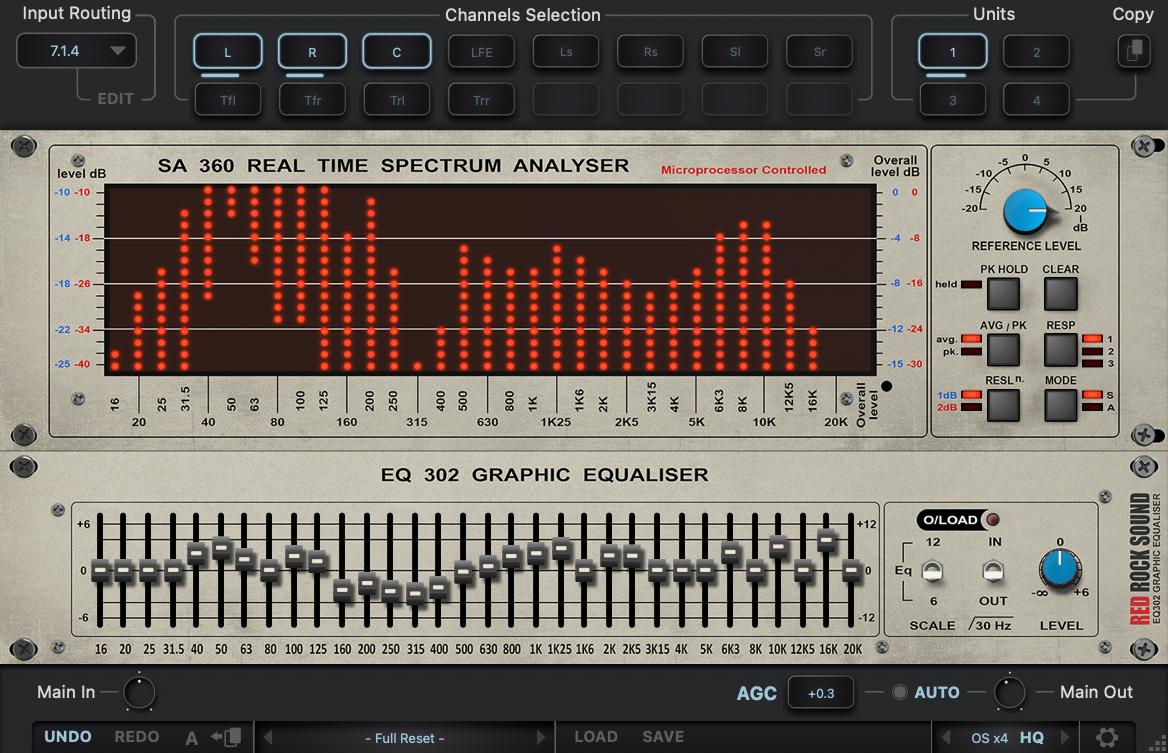Spectrum analyzer for immersive audio.

SA360 Immersive Spectrum Analyser
SA360 real time 1/3 octave Spectrum Analyser and EQ302 32 band Graphic Equaliser
combine ease of use, accuracy and versatility in one economical, reliable unit.
The SA360 extends the features of the original hardware and joins the flexibility of the digital
world to the character of the analog processing. The SA360 plugin designed from the ground
up for fast, efficient work on mid/side, stereo and the objects, the beds (fixed channels) of
immersive mixing environments.
INPUT ROUTING PANEL

Groups
This module allows you to select an analyser/equalizer from four available. The analyser/equalizers are arranged in series, this allows you to process channels with different equalizers settings.
For example: the first analyser/EQ is only the mid channel, the second analyser/EQ is only the side channel, the third analyser/EQ is the left and right channel. For multi-channel modes: the first analyser/EQ is only the left and right channels, the second analyser/EQ is the center channel, the third analyser/EQ is the LFE, etc.
You can rename Group Buttons for ease of use. To rename the selected Group button, right-click on the button.
In order to turn on the solo (listen) of the analyser/equalizer, double-click on the selected analyser/equalizer number. The analyser/equalizer in solo mode glows yellow, to exit solo mode, double-click again. For two-channel modes, only one analyser/equalizer can be solo mode. For multi-channel modes, one or more analyser/equalizers can be soloed.
To bypass analyser/EQ processing, press the selected analyser/equalizer number one click + shift. In bypass mode, the button will glow red.
You can also copy all analyser/equalizer settings to another analyser/equalizer. To do this, select the analyser/equalizer from which you want to copy the settings, then click on the copy button, then select the analyser/equalizer to which you want to copy the settings.
Input Routing
Input Routing lets you choose between 44 common channel setups, starting from Stereo up to 7.1.4 and 9.1.6. Simply select in the input routing module the channel setup that fits your track.
You can also create your own input routing profiles. 16 independent channels are available.
Click on the edit button next to the input routing selection display. Hold down the shift button and select the desired number of channels. Name selected channels in order. Then click save and name the profile.
Channels Selection
In this module, you can select (activate) the channels that the analyser/equalizer (group) will process.
ANALYSER SECTION
Red Rock Sound SA360 real time 1/3 octave Spectrum Analyser combines ease of use,
accuracy and versatility in one economical, reliable unit. Interface is modelled on classic
DN60 spectrum analyser, originally developed in 1980.

DISPLAY LEVELS
Relate to the Reference level, calibration of a display level is read from graticules on the left
of the display window.
OVERALL LEVEL
Calibration of the overall level is similary derived from graticule to the right of the display.
Note: this graticule applies to the overall level only!
REFERENCE LEVEL
The absolute level to which display readings are relative, i.e. calibration, is given in dB.
AVG/PK
Two leds indicate whether the display is Averaging or Peak-reading.
RESP.
Speed of display response is selectable: «1» — Fast, «2» — Medium, «3» — Slow, shown by
three leds. Attack and Decay in Avg. mode, (Decay only in Peace mode.)
RESLN.
Governs the display resolution: switchable to either 1dB or 2 dB per graduation, and two leds
right the switch indicate which is selected.
MODE
Controls the display mode: «S» — Selected channels in selected Fx, «A» — All
channels out.
EQUALIZER SECTION
EQ302 is a 32 band equaliser offering 12 dB of cut or boost in 1/3 octave steps between the
frequencies of 16 Hz and 20 kHz.

Overload LED
The Overload LED The signal level is monitored at several separate points within the circuitry
of the unit, and any one of these signals exceeding a threshold, set 3dB below clipping, will
cause the LED to light.
SCALE
In order to offer operational flexibility a variable fader resolution has been incorporated i.e. 6
or 12 dB cut or boost.
The scale switch selects maximum boost and cut for the equaliser of either 6dB or12dB.
30Hz LOW CUT FILTER
Low cut filter switch enables a 30Hz subsonic filter to be connected in or out of circuit.
INPUT LEVEL
The Input level control allows the system gain to be up to+6dB when in its fully clockwise
position, and offers full attenuation in its anti-clockwise position.
BOTTOM SETTINGS PANEL

Global Input Gain
Main Input Gain controls the overall input level of the plug-in input, before all fx modules.
OGC (Output Gain Control)
To activate the Output Gain Control mode, click on the OGC button.
Below is located Compensate display that after a while will show you the level difference. Click on it to compensate for the difference.
Auto Mode
Click on the "AUTO" button to turn it on. If the gain difference is bigger than the "gain tolerance" then the AUTO LED becomes yellow and the plugin actively adjusts the gain (you'll see the knob slowly rotating).
Note: For more detailed settings of the OGC mode, go to "Global Preferences".
Global Output Gain
Main Output Gain Main Output Gain controls the overall output level of the plug-in output, after all fx modules.
Undo/Redo
Undo and Redo functions allow undo and redo of changes made to the plug-in parameters.
A/B
A/B buttons allows you to load two independent settings and compare them quickly.
Preset Display
Factory presets are included in the plug-in installation, installed in the following locations:
Mac: Users\[user name]\Music\Red Rock Sound\RRS SA360\Patches
Windows: C:\Users\[user name]\Documents\Red Rock Sound\RRS SA360
You can save the current settings as the Default preset. - Full Reset – is the default preset
Load
Load button allows loading of presets not stored in the locations described above.
Save
Save button allows for save of user presets.
Oversampling
OS x_ activates 2x, 4x or 8x oversampling, 1x disables oversampling.
(note that when the HQ mode is on, CPU will be loaded more than usual).
HQ mode (HQ)
HQ mode is for oversampling, it adds a higher order antialiasing filter. It improves processing quality, but also leads to an increase of the CPU load.
Global Preferences
Button opens Global Preferences menu.
AGC SETTINGS
RMS TIME
By default, the RMS time (the averaging time for loudness calculation) is set to 2 sec. You can change it from 0.6 sec to 10 sec when the time indicator is displayed.
FILTER TYPE
Flat
This means that the signal is not processed (Flat) or filtered before measuring.
K-Weighted
This means that the signal is filtered (K-Weighted) before measurement (it's used by default).
SUSPEND COMPARISON
It is useful when you're in AUTO mode and your track has silent areas.
By default when "Suspend comparison" is enabled and the signal is very low, the plugin will not perform any activity (will not compare levels, cause the signal is too low, and will not adjust the gain in the AUTO mode).
By default the threshold for "suspend comparison" is set to -60 db.
AUTO
Auto gain tolerance (the amount of gain difference that makes AUTO active).
The right value is the maximum value of gain that AUTO can apply.
Maximum Positive or Negative Gain Adjustment
Use separate limits for gain adjustment allows you to set negative and positive auto limits independently. This way you can have AUTO adjustments ranging (for example) from -20 to +10 dB, or from -18 dB to +4dB, etc.
D3D / OGL / CPU (Windows)
This switch allows you to choose between GUI rendering engine:
Normally, no need in switching rendering mode manually, plug-in try to initialize D3D9 then OGL (if D3D9 failed) and CPU (if OGL failed) automatically. But if you have problems with the GUI, you can manually switch and test different rendering methods at work.
This switch is available only in the Windows version of the plugin. For the Mac version, this is not necessary.
Note: Drivers of some video cards (for example, Intel Arc A380) in D3D mode adversely affect the plug-in (periodic noise or whistle), if you encounter a similar phenomenon, use OGL or CPU.
SIMD optimization
This switch enables or disables SIMD optimization, it can be used by multichannel processing with high oversampling. It is undesirable to use in mono and stereo modes, SIMD only slows down the plug-in due to the overhead of splitting the data for optimization.
(Currently in beta testing)
SIMD MacOS
- In the ARM version, you can enable or disable NEON; - In the Intel version, you can enable or disable SSE2.
SIMD Windows
- In the Intel version, you can enable or disable AVX (if supported), or SSE2.
The Windows version has a limitation: if the CPU does not support FMA, then the optimization will not work, even if AVX or SSE2 is supported.
Note: Enabling/disabling SIMD is saved in the project for each plugin individually. i.e. if a specific instance of the plugin slows down, then you can enable SIMD for it, and others, if they are in the project, will not be affected by this optimization.
COMPATIBILITY




System requirements
All Red Rock Sound products require a computer with appropriate DAW host software (none of which are included).
Plug-in Activation requires Internet connection!
You can go offline as soon as plug-in is successfully activated.
Versions from 1.0.0 and newer of the Red Rock Sound plug-ins have the following minimum requirements:
Mac OS X 10.14.6 or higher for AU.
Mac OS X 10.14.6 or higher for VST.
Mac OS X 10.14.6 or higher for AAX. Latest version of iLok license manager.
Windows 7 or higher (Windows XP not tested).
Mac: Intel Core i3 / i5 / i7 / Xeon / Full Apple silicon support (M1 or higher).
Windows: Intel Core i3 / i5 / i7 / Xeon / AMD Quad-Core or newer.
In theory, any AAX, VST, VST3, AUv3 compatible host application should work. However, due to plug-in host differences between DAWs - and our own rigorous testing standards - we only officially test our plug-ins and instruments in the most recent versions of Pro Tools, Logic Pro, Cubase, Ableton Live, Studio One, Reaper, and Bitwig. Red Rock Sound plugins are not tested in non-listed systems, but they most likely work as long as the system requirements are met. We cannot guarantee a solution for issues in unsupported systems.